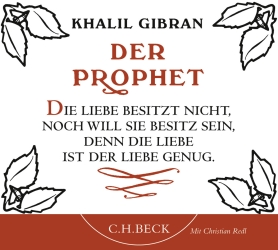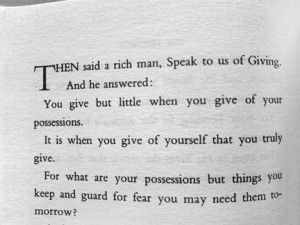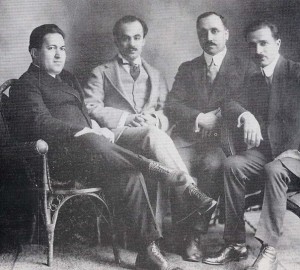KHALIL GIBRAN´s PROPHET & THE MARONITES
KHALIL GIBRAN – Works, Arts & Museum
Maronite Center for Documentation & Research
http://www.tlig.org/en/interreligious/
* A 1920 photograph of four prominent members of The Pen League (from left to right): Nasib ‘Arida, Kahlil Gibran, ‘Abd al-Masih Haddad, and Mikhail Naimy.
Khalil Gibran (born Gubran Khalil Gubran bin MikhÄ�’Ä�l bin Sa’ad; Arabic جبران خليل جبران بن ميکائيل بن سعد, January 6, 1883 – April 10, 1931) also known as Kahlil Gibran, was a Lebanese American artist, poet, and writer. Born in the town of Bsharri in modern-day Lebanon (then part of the Ottoman Mount Lebanon mutasarrifate), as a young man he emigrated with his family to the United States where he studied art and began his literary career. He is chiefly known for his 1923 book The Prophet, a series of philosophical essays written in English prose. An early example of Inspirational fiction, the book sold well despite a cool critical reception, and became extremely popular in the 1960s counterculture.Gibran is considered to be the third most widely read poet in history, behind Shakespeare and Lao-Tzu. Gibran was born in the Christian Maronite town of Bsharri (in modern day northern Lebanon) to the daughter of a Maronite priest. Read More: > HERE <
The Maronite Church (Arabic: الموارنة, Turkish: Maruni, Syriac: Ü�Ü�Ü�Ü�Ü�Ü�, Latin: Ecclesia Maronitarum) is an Eastern Catholic Church in full communion with the Holy See. It traces its heritage back to the community founded by Maron, an early 5th-century Syriac monk venerated as a saint. The first Maronite Patriarch, John Maron, was elected in the late 7th century. Before the conquest by Arabian Muslims reached Lebanon, the Lebanese people including those who would become Muslim and the majority who would remain Christian, spoke a dialect of Aramaic.Syriac (Christian Aramaic) still remains the liturgical language of the Maronite Church.The members of the Maronite Church are a part of the Syriac people. Read More: > HERE <
Kahlil Gibran – The Prophet – Much of Gibran’s writings deal with Christianity, especially on the topic of spiritual love. His poetry is notable for its use of formal language, as well as insights on topics of life using spiritual terms. Gibran’s best-known work is The Prophet, a book composed of twenty-six poetic essays. The book became especially popular during the 1960s with the American counterculture and New Age movements. Since it was first published in 1923, The Prophet has never been out of print. Having been translated into more than forty languages, it was one of the bestselling books of the twentieth century in the United States.
Khalil Gibran – A Retrospective
The Prophet is a book of prose poetry that made its Lebanese-American author famous. Commonly found in gift shops and frequently quoted at weddings or any occasion where uplifting ’spiritual‘ thoughts are required, the work has never been a favorite of intellectuals – to some readers it may seem a bit twee or pompous – yet its author was a genuine artist and scholar (see bio, below right) whose wisdom was hard-earned.
The Prophet provides timeless spiritual wisdom on a range of subjects, including giving, eating and drinking, clothes, buying and selling, crime and punishment, laws, teaching, time, pleasure, religion, death, beauty and friendship. Corresponding to each chapter are evocative drawings by Gibran himself.
Final word – Taken as a whole, Gibran’s book is a metaphor for the mystery of life: we come into the world and go back to where we came from. As the prophet readies himself to board his ship, it is clear that his words refer not to his journey across the seas but to the world he came from before he was born. His life now seems to him like a short dream.
The book suggests that we should be glad of the experience of coming into the world, even if it seems full of pain, because after death we will see that life had a pattern and a purpose, and that what seems to us now as ‚good‘ and ‚bad‘ will be appreciated without judgment as good for our souls. > Full Article & Order <
The prophet also teaches that the separation we feel from other people and all forms of life while on earth is not real. We are merely expressions of a greater unity now forgotten. As he looks forward to his journey, Almustafa likens himself to „a boundless drop in a boundless ocean.“ To feel yourself to be a temporary manifestation of an infinite source is greatly comforting, and perhaps accounts for the feeling of peace and liberation many experience in reading The Prophet.
Tagore, Rilke, Gibran: A Comparative Study – In Tagore, Rilke, Gibran Dr Rosy Singh deals with the recurrent metaphysical theme of love, harmony and peace in an age when social realism and western materialism had all but swept away any literary interest in mysticism. These three poets of East and West reflect on the destiny of Man in correspondence with the Divine Nature in all its sublimity and serenity.
After her doctorate on the Existential Situations in Franz Kafka from Jawaharlal Nehru University DR. ROSY SINGH teaches German at Delhi University. Her recent publication is Rilke, Kafka, Manto -the Semiotics of Love, Life and Death.
Foreword: Tagore, Rilke, Gibran-a Comparative Study by Dr. Rosy Singh of Delhi University is an Associate of the UGC Inter-University Centre at the Indian Institute of Advanced Study. She deals with three very significant metaphysical poets of east and west at the turn of the century when Nietzsche’s proclamation of the Death of God and Marxist social realism had all but swept away academic interest in mysticism. The lyrics of these poets kept the melody of love, harmony and peace tuned to the imagination of humanity. I am happy to present this incisive study as Occasional Paper of Inter-University Centre to the students of comparative literature and philosophy.
- DER BAUORDEN <
- Isralestinian Ghandis – Meditation for Peace <
- Ecumenical Patriarch Bartholomew I of Constantinople.“The Green Pope“ <
- Kahlil Gibran Man and Poet, A New Biography <
- Tagore, Rilke, Gibran: A Comparative Study by Rosy Singh <
- Jawaharlal Nehru University, NEW: Conferences 2010 <
- Meet Khalil Gibran, friends, fans at fb <
- Khalil Ghibran´s The Prophet , friends, fans at fb <
- Meet Maronite Church, studies, friends at fb <
- Meet the Maronites of Australia, studies, friends at fb <
- Meet M.K. Gandhi Institute for Nonviolence, friends, fans at fb <

CD HÖRBUCH: > HERE <
( „The Love dont posses, neighter wants to be in posses,
because the love, is love the loving/love enough “ )

Comments are closed.
